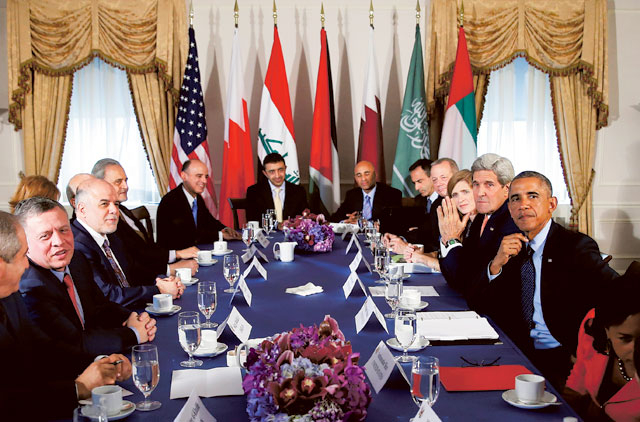With world’s attention focused on the international campaign against Daesh (Islamic State in Iraq and the Levant) in Iraq and Syria, Al Houthis in Yemen, a Shiite minority group comprising 20 per cent of the population, have been making spectacular gains on the ground heralding a major geopolitical shift in this tribal and poverty stricken, but strategic, country on the southwestern edge of the Arabian Peninsula. The rebel group’s takeover of the capital Sana’a last September and its quick advance in other areas, including the south and west, is bad news for Saudi Arabia and by extension the rest of the Gulf states.
No one expected Al Houthi militias to force their way on the political scene so quickly that they have become the major power broker in Yemen. Until this summer they had been challenging government control from their home region of Saada, in the north. Their armed rebellion goes back to 2004 and they had come under successive attacks by the army of ousted president Ali Abdullah Saleh resulting in the killing of a number of their leaders. But their power began to grow in the aftermath of the popular uprisings that gripped Yemen in 2011 which culminated in a Saudi-brokered deal to remove Saleh in 2012.
His successor President Abd Rabbo Mansour Hadi launched a national reconciliation process, which Al Houthis initially joined then boycotted. They continued their armed insurgency taking over the governorates of Saada and most of Amran and Al Jawf. President Hadi’s grip over the army and security forces remained lax and ousted president Saleh was accused of breaching his commitments and sabotaging the political process. It was when the government raised the price of fuel last September that angry demonstrations broke out in the capital. This was the cue for the Al Houthis, whose numbers are estimated at 100,000 armed fighters, to make their move on Sana’a. It took them a few weeks to reach the outskirts of the capital. Initially, the army resisted them but by mid-September the rebels marched into the capital and took over key government ministries without resistance.
President Hadi caved in to their demands and fired the government. UN special envoy Jamal Benomar intervened and made an unexpected breakthrough. Al Houthis, led by Abdul Malek Al Houthi, signed the “Peace and National Partnership” agreement, but in spite of promises to withdraw they maintained control of the city. On Tuesday, Hadi bowed to pressure and named former oil minister and the country’s envoy to the United Nations, Khaled Bahah, as prime minister.
Still Al Houthis continued their advance and in the past few days they managed to spread their control over most of western and northern Yemen, including the strategic Red Sea port of Al Hudaida. They stopped short of taking Taaz, but secured a border town on the Saudi border.
Al Houthis’ stunning ascent to power has taken regional players by surprise. But their rise could not have happened without external help. Hadi had accused Iran of aiding the insurgency, and under pressure from Al Houthis he recently set free a number of Iranians which the authorities claimed were members of the Revolutionary Guard. Hadi had also accused Lebanon’s Hezbollah of training the Al Houthi militia and again was forced to release two operatives allegedly belonging to that group. The Iran-Hezbollah connection to the rebels is not new, but in light of Al Houthi takeover of most of Yemen that connection has raised red flags in Riyadh and other Gulf capitals.
Last week the GCC said that “it would not stand idle in the face of factional foreign intervention in Yemen whose security and the security of the GCC states is one and the same.” The upheaval in Yemen has also soured relations between Riyadh and Tehran in spite of earlier indications that a political breakthrough was imminent. Last Monday, Saudi Foreign Minister Saud Al Faisal lashed out at Iran, accusing it of having forces inside Syria, Iraq and Yemen, and insisting that Tehran is “part of the problem” in these countries.
Yemen has always been part of the political sphere of influence of Saudi Arabia. Since the 2011 uprising and the ousting of president Saleh, Riyadh has watched Iran’s weight grow in two neighbouring states: Yemen and Bahrain. The conflict with Iran has extended to Iraq, Syria and Lebanon, giving credence to Saudi fears that Tehran was looking to become a regional power broker.
But Yemen poses a special problem for the Gulf states. The Houthi challenge is one aspect of it. The weakening of the central government in Sana’a has encouraged the Hirak in the south to renew calls for secession. Protesters in Aden have given the government until November to withdraw from the south and there are signs that their efforts are being backed byAl Houthis.
The recent developments in Yemen have awakened another old nemesis of Saudi Arabia; Al Qaida which has mobilised to confront Houthi expansion on sectarian grounds. Disgruntled Sunni tribes in Yemen may find an ally in Al Qaida to relieve them from the domination of the Houthis. Local Sunni tribes have clashed with Al Houthi rebels in Al Baida province on Friday. They were backed by Ansar Al Sharia, an Al Qaida-linked militant group.
By aiding the Al Houthi insurgency in Yemen Iran hopes to distract Saudi Arabia and the Gulf states who have been at the forefront in backing the Syrian rebellion against the Damascus regime. As things stand the GCC can do little to stem the tide of the Al Houthis at this stage. And if the southern Hirak movement carries out its threat to secede then Yemen could be heading towards civil war very soon.
Osama Al Sharif is a journalist and political commentator based in Amman.













